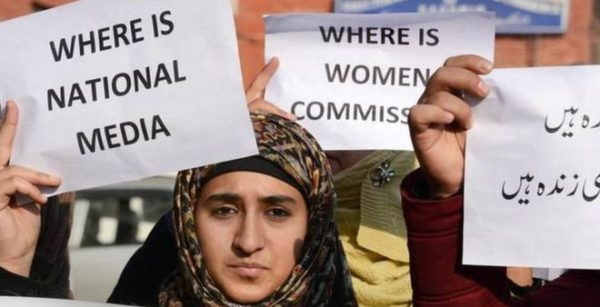A bright looking eight-year old girl belonging to a Muslim nomadic tribe in Indian-administered Kashmir goes missing in the new year.
On 17 January, her battered body is recovered from a forest in Kathua district. Through February, police arrest eight men, including a retired government official, four policemen and a juvenile, in connection with the gang rape and murder of the girl.
There are protests in the summer capital, Srinagar, demanding a special probe into the incident. The crime exposed the fault lines between the Hindu-majority Jammu and the Muslim-majority Kashmir valley in a sharply divided state. The incident is covered promptly and prominently by the local media in the Muslim-dominated valley.
So why does this story from Kathua make it to national news networks only in mid-April? Why does it evoke delayed outrage and anger? Why does this happen only after Hindu right-wing groups protest the arrest of the accused, who also belong to a Hindu community?
Why are the eventual protests in Delhi – including a midnight march by chief opposition leader Rahul Gandhi – milder than the ones after a similarly brutal gang-rape and murder of a 23-year-old woman in Delhi in 2012?
The responses tell us something about modern India.
The media in Delhi, many believe, exerts a disproportionate and undeserved influence over shaping the “national narrative”. And large sections of this media have been partisan and selective when it comes to reporting on Kashmir, one of the world’s most heavily militarised regions.
India and Pakistan have fought two wars and a limited conflict over Kashmir and there’s been an armed revolt in the region against Indian rule since 1989. “The biggest problem in Kashmir is the way the place has been covered in the mainland Indian media,” wrote senior journalist and editor of The Print, Shekhar Gupta, in 2015. “The problem has always been very closely linked to national security and military security.”
So, often, the truth (about Kashmir), he wrote, “was considered against national security”.
In this instance, one could possibly cite “religious honour” as another reason for why most national media avoided reporting on the crime. The support shown to the accused by Hindu right wing-groups – and two ministers from the ruling Bharatiya Janata Party (BJP) – has shocked many.
Prime Minister Narendra Modi only broke his silence on Friday evening with a series of tweets, saying “no culprit will be spared… our daughters will definitely get justice”.
‘Not such a big story‘
A journalist who has been covering the incident in Kathua since January says that he had been telling his colleagues who work for Delhi-based news networks to report on the crime and its aftermath.
“When some of the reporters approached their offices in Delhi to tell them about the incident, the feeling was that the inauguration of a garden of tulips in the valley was a better story than the rape and murder of a girl,” Sameer Yasir, an independent Srinagar-based journalist, told me.
According to Mr Yasir, most of their bosses prevaricated, saying they didn’t have enough people on the ground in Jammu, and that it was not “such a big story”. Only one English news network has been consistently covering the story.
“I believe that media is almost tired of reporting violence in India. Rapes, lynching, torture is being reported all the time. It’s almost like you have to run a torture report, like the weather report,” says Shiv Visvanathan, a Delhi-based social scientist.
It is possibly all about what Dr Visvanathan calls the “breakdown of moral imagination” in India. Writing in The Indian Express newspaper, Pratap Bhanu Mehta, a leading public intellectual, agreed, saying the Kashmir rape and murder proves “without exaggeration, that India’s moral compass has been completely obliterated, carpet-bombed out of existence by the very custodians of law, morality and virtue who give daily sermons on national pride”.
In a deeply divided society, collective action is always difficult. Outrage happens – as in this case – when graphic details of the torture inflicted on the girl stir the conscience of many. This is what happened in this case.
‘Rip Van Winkle outrage‘
Many say the equally horrific 2012 Delhi gang-rape provoked huge protests in the capital because the victim was like “one of us” who was attacked on the way home with her male friend after watching a Hollywood film at a cineplex. On the other hand, the girl in Kathua was a veritable vagabond, a member of a poor nomadic community, languishing bottom-most in India’s unforgiving and cruel caste hierarchy.
“Everyone is complicit – we the people, media, politicians. There’s no concept of human rights anymore. There are Hindu rights and Muslim rights. Our loyalties are now to religion, caste, groups and clubs,” says Dr Visvanathan.
In this environment, say many, instant outrage and “whataboutery” are the two extreme emotions that violence like this provokes. The outrage waxes and wanes quickly – Dr Visvanathan calls it the “Rip Van Winkle nature” of outrage and indignation.
“Our reactions veer from silence to indifference to hysteria. Then we go back to sleep and wake up again to react to the latest incident of outrage”.






Leave a reply